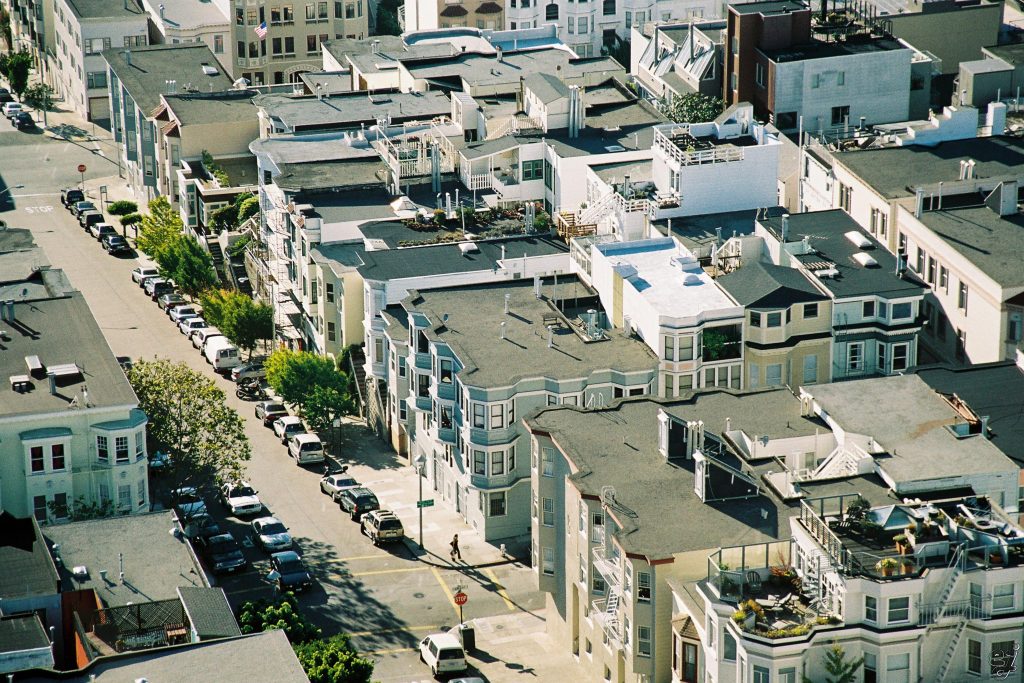by Verona Teo
The San Francisco Bay Area, once home to diverse populations, has been constantly changing since the 1990s. Lower income families are moving away at increasing rates to seek more affordable housing.
According to the National Community Reinvestment Coalition, gentrification rates are higher in the Bay Area than anywhere else in the United States. Although there are many elements that affect population dynamics within cities, green gentrification is a recent phenomenon that has significantly shaped the region’s neighborhoods, cities, and populations.
“Green gentrification,” also known as environmental or climate gentrification, is the process in which the implementation of eco-friendly amenities and environmental planning agendas increase property values and thus attract wealthier populations (Barcelona Laboratory for Urban Environmental Justice and Sustainability). While gentrification overall has been a topic of debate for quite some time, the idea of climate gentrification is one that has become more popular relatively recently.
As the effects of climate change have become more well known, local government officials have adjusted their policies to make cities more climate resilient. Cities are implementing electrification reach codes, constructing more sustainable buildings through the use of sustainable materials and renewable energy, and using land for recreational parks and conservation.
As a result, data from the Urban Displacement Project shows that there are higher property values, an influx of wealthier populations, and a departure of lower-income communities in the Bay Area. These trends have caused researchers and activists to question how residents are being impacted by such policies.
Alex Werth, a policy associate at the East Bay Housing Organizations, said, “[Green spaces and amenities] are geared toward certain populations. Cultural spaces like parks, investments, infrastructure all appeal to newcomers and wealthier consumers.”
As an urban geographer who has previously worked with local government officials, Werth has seen how the policy making process occurs at the local level.
“City governments were very clear they wanted to attract new businesses and residents, and that was part of the intentions behind the [green] development efforts,” said Werth.
According to Werth, part of the reason for such intentions is that local governments are very dependent on certain revenues. California specifically is highly constrained because of Proposition 13, a failed proposition that sought to allocate money towards schools.
Karen Chapple, a UC Berkeley professor and founder of the Urban Displacement Project, brings up a similar idea to Werth’s: the concept of the “entrepreneurial city.”
“Cities are collectively thinking about how they can make themselves attractive and bring in more tax revenue and high-income people,” said Chapple.
However, the implementation of such policies and green development efforts have affected Bay Area residents unequally. According to Alex Nutkiewicz, a Ph.D. Civil and Environmental Engineering candidate at Stanford University, energy efficiency and building retrofits are unequally distributed towards higher-income communities. Such development efforts are catered towards those who can afford it, although their impacts tend to be more significant for people of lower income.
For example, according to an article by Resources Magazine, lower-income residents who live in older buildings often do not have access to air conditioning. This makes them more susceptible to the higher levels of heat that Californians have been experiencing over the past few years.
“There is an overall lack of awareness of how upfront costs of implementing building retrofits can have such great downstream effects on buildings’ energy use,” said Nutkiewicz.
Such retrofits can include adding rooftop solar or improving a building’s energy efficiency According to Nutkiewicz, while energy efficient buildings might raise property values, they ease utility costs, which can offset this price difference.

However, it is not yet entirely clear how much of an impact green gentrification has had on the Bay Area’s changing population trends. It can be difficult to decipher the intentions behind the policy making process, such as determining whether local policies related to climate initiatives like clean energy, green infrastructure, and parks are set with underlying intentions to attract wealthier populations or to improve quality of life.
“There’s a long-standing debate on whether development and population changes in neighborhoods are driven by production or consumption,” said Chapple. “While production is partially driving inequality, consumption shows that consumer preferences have changed. For instance, people today want more parks, recreation spaces, and different types of accessible transportation.”
Such preferences have impacted housing prices.
“With parks and green spaces, [more] people want to live near there. And so typically, housing prices are much higher near these larger, more recreationally-driven areas,” said Nutkiewicz.
Tim Frank, a partner of the Housing Leadership Council and policy professional with over 20 years of experience working on issues surrounding land use, transportation planning, and economic development, argues that gentrification in the Bay Area is not driven by climate so much as it is driven by people’s preferences.
For instance, one element that plays into mobility and dynamics within cities is the Bay Area’s robust public transportation system. Frank explained that home buyers in Berkeley are more likely to be in the tech industry, so they value being close to public transit. This in turn drives higher property values.
Other policy experts and researchers believe that it is the lack of affordable housing in lower-income communities that are the most significant causes of gentrification and displacement in the Bay Area.
Frank said, “There is a huge amount of underused land and exclusive communities here, which provides part of the explanation for the lack of housing and gentrification.”
Advocates also point to a lack of investment in lower-income communities as another reason.
“Underinvested neighborhoods lead to displacement because increases in costs of living are larger than wage increases. Property taxes also go up, which can be very destabilizing,” Werth said.
Although climate gentrification and displacement are complex issues that will have long-lasting impacts on cities and populations, there are several ways to help mitigate them.
Some possible solutions to reduce the effects of gentrification include requiring developers to build a certain number of affordable homes, implementing policies that guarantee residents’ rights to stay, and offering grants and other incentives only to developers committed to affordable housing.
Chapple said, “[It’s important to] reduce income inequality and provide more housing support so people can afford to live where they are.”
Both Chapple and Frank highlighted how cities must take joint action at the local, state, and national levels to reduce the effects of gentrification. Werth also brought up the importance of improving planning processes within green planning.
“Planners and policymakers should take advantage of the large amounts of data available on buildings, energy, market fluctuations, and population changes to make data-driven and informed policies,” said Nutkiewicz. “We need to leverage access to the data that we have to improve how cities function.”
While some of green gentrification’s negative effects towards certain populations can be counteracted by such solutions, Werth stressed the importance of how cities must listen to those most at risk of gentrification.
“There needs to be an urban shift in priorities. We must empower the voices of residents who live here,” said Werth.

Verona Teo (she/her) is a first-year student planning to study Philosophy, Economics, and Data Science. As an environmental activist and student who enjoys reading and writing, she wanted to join Perennial to combine and expand on these interests. Through Perennial, she hopes to not only inform others about our climate and environment, but also encourage people to speak and act on such issues. She spends a lot of time playing music, making art, writing songs and poetry, and skateboarding.

